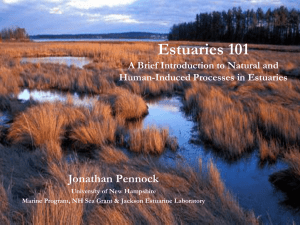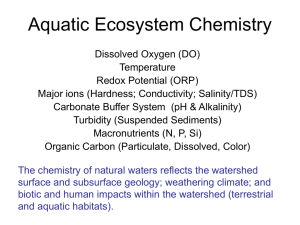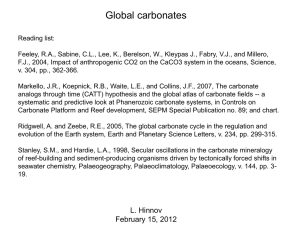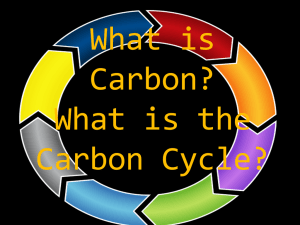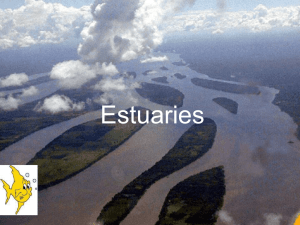Estuarine Cycles (PPT)
advertisement
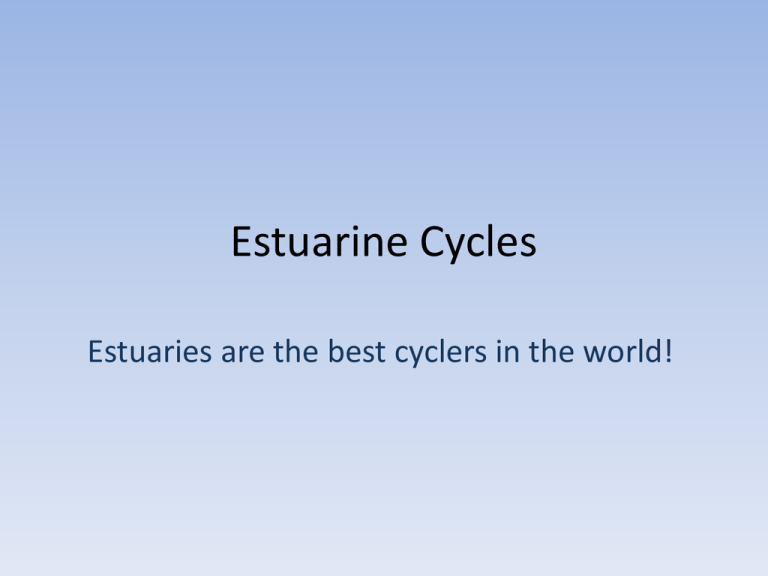
Estuarine Cycles Estuaries are the best cyclers in the world! Sulfur • There are many forms of sulfur in estuaries • Sulfur is a good oxidation-reduction element (redox) • Seawater contains high amounts of SO4 • When sulfate is reduced it by phytoplankton, it becomes dimethylsulfoniopropionate (DMSP) to volatile dimethyl sulfide (DMS) DMS • The molecule DMS CH3-S-CH3 • Approximately 50% of the global flux of S is derived from the marine environment. • Oxidation of DMS leads to production of SO4 in the atmosphere The Reduction of Sulfate • Some SO4 reducing bacteria (SRB) are closely related with the rhizophere of Spartina alterniflora (control biogeochemical cycling in marsh sediments) Sulfides in the soil… Lucinid Bivalves Lamars et al. 2013 SRB • Some of the reducing bacteria families include: Desufovibrionaceae Desulfobacteriaceae Examples of bacteria…. Desulfovibrio desulfuricans Desulfobacterium spp. Image University of Hawaii Back to Sulfates? • A significant fraction of sulfides by SR are reoxidized to sulfates at the “oxic-anoxic” sediment interface • Dissolved Sulfides can diffuse into bottom sediments and can contribute to further O2 depletion in estuaries through oxidation. Sulfides • They are not retained in sediments in estuaries • Are variable based on location, depth and temperatures • Can also vary if there is iron present Pyrite is a crystal form of Iron sulfide Oxidation Reduction Potential • Measures the amount of oxidizers, those wanting to take oxygen from the environment. Some include: Chlorides, Bromides, Ozone Because these oxidizers steal electrons, there is a higher ORP reading! Higher voltage! ORP • The less available oxidizers, the lower the potential and lower the ORP reading which means there are more chances for a reducing environment • In short the more negative – reducing conditions, the more positive – oxidizing • Ranges -1200 mV to +1200 mV Carbon Carbon • It is necessary for biological functions and is the key element on earth (over 1,000,000 compounds) • Oxidation states from +4 to -4 • Has both long-term and short-term cycles • We will focus on the “carbonate reservoir” (Holmen, 2000). Carbonate Reservoir Dissolved Inorganic Carbon •DIC – Bicarbonate, carbonate, carbon dioxide Solid Carbonate Minerals •Calcium carbonate Complex Carbon Cycles • Methane and carbon dioxide are the gases that get attention as they are “greenhouse gases” Methane Carbon dioxide Inorganic Carbon • The processing of inorganic forms of carbon in phytoplankton are important for short-term process. Inorganic to Organic Form Now an organic form for zooplankton to use for energy The Cycle Continues… Through heterotrophic functions (respiration), it is now back to the inorganic form Iron was found to be one of the limiting components to “control” phytoplankton populations How about increasing the amount of autotrophic species through iron fertilization? There is a Southern Ocean Iron Enrichment Experiment Ratios of Carbon Carbon was found to be in ratios with N as follows… C/V Terrestrial Leaves Trees Marine Plants Zostera marina Spartina alterniflora Marine Macroalgae Browns Greens Reds Microalgae & Microbes Diatoms Greens Bacteria Fungi 100 1000 17 – 70 24 – 45 30 (mean) 10 – 60 20 6.5 6 5.7 10 Carbon emissions? • Marshes, inner waters and tidal flats are thought to be the largest producers of carbon dioxide in terms of ecosystems. • Reasons, types of biota in estuaries, thus produce carbon dioxide. • Estuaries are thought to be net heterotrophic. Guess what this is?
